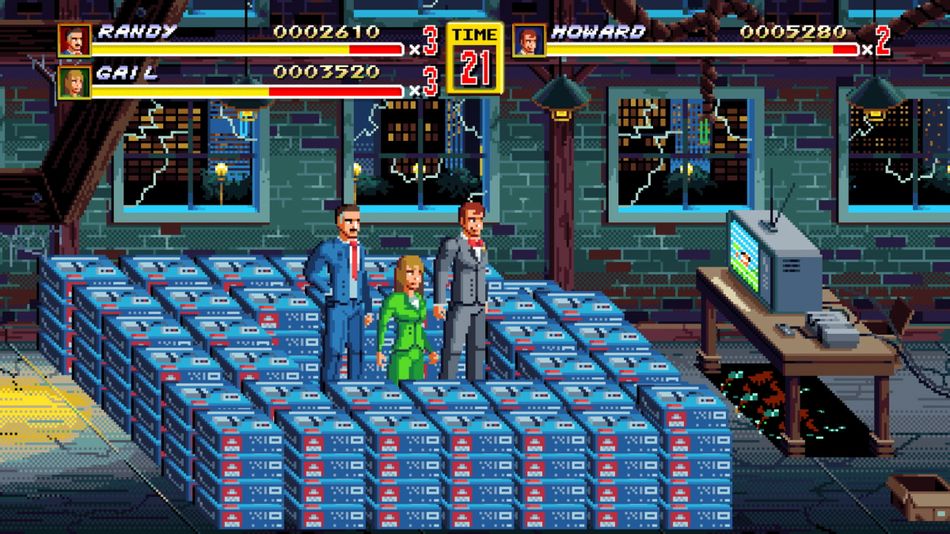I can say this much about Console Wars, the new CBS All Access doc about the Nintendo vs. Sega clash of the 1990s: It’s lovely to look at.
The 90-minute journey into mainstream gaming’s formative days could have easily landed as a dry account of the business machinations behind gaming’s earliest console “war.” But the documentary is awash with archival footage and creatively designed interludes that insert key players into pixelated scenes that themselves resemble video games.
So when former Nintendo marketing executive Peter Main describes a verbal dispute he had with Sega of America’s ex-CEO Tom Kalinske that led them into the snowy streets of Manhattan, it’s not just talk. We see a Street Fighter-like fight scene featuring a gang of blue suits lined up against a gang of red suits, with the two central players squared off beneath a dim streetlight.
There are flourishes like graffiti and torn posters adorning a brick wall in the background and dirty piles of snow visible in the foreground. The two contenders – “Tom” and “Peter” – each have a health bar and a score. And of course, at this early point in the competition when Nintendo was still the most dominant force on the market, it’s Peter with the higher score.
For what it is, Console Wars provides a fascinating peek behind the scenes of an industry that is often seen as overly secretive. We hear from many of the key players who drove the showdown between Nintendo and Sega back in the ’90s, and with that comes firsthand accounts of how competing plots were hatched.
For what it is, Console Wars provides a fascinating peek behind the scenes.
The talking head interviews paint the picture of a scrappy, young company in Sega taking on Nintendo’s near-monopoly in the late ’80s and early ’90s. Sega saw the weakness in Nintendo’s family-friendly, all-ages strategy, and so the U.S. launch of the Genesis capitalized by targeting an older audience with adult-friendly games and an edgier mascot than Mario in Sonic the Hedgehog.
The documentary introduces us to a cast of colorful characters like Kalinske, the upstart former Mattel exec who revived Barbie before he joined Sega and effectively wrote the script for a successful Genesis launch. Opposite him is Howard Lincoln, the straight-laced former Nintendo chairman who was at the forefront of efforts to meet Sega’s blossoming competition head-on.
Competing narratives show us how the two men and their respective companies butted heads for control of the market. But the story Console Wars tells isn’t exactly linear. After an extended introduction mapping out Nintendo’s early U.S. explosion with the NES, we turn to Sega and the story of how the Genesis was born, marketed, and eventually released.
It’s only after the Sega picture is laid out that the clock spins back a few years to show us Nintendo’s side of the story. It’s a jarring shift. As Sega’s crew fades into the background to make way for Nintendo, we run back through some of the same events covered earlier, but from the opposing perspective.
Console Wars also never seems to land on a point, even though there are plenty to be made. Time jump aside, it’s a perfectly engaging account of a moment in history. But the story is also in many ways laying out a blueprint for the way competition in the video game industry took shape over subsequent decades.
Take Sega’s hyping of “blast processing,” a bullshit technical feature that never actually surfaced in a shipped game at the time. The documentary shows us how the company simply wielded the term as something that sounded cool for an older audience.

Image: Best Possible Screen Grab CBS ©2020 CBS Interactive, Inc. All Rights Reserved.
There are echoes of that empty hype evident now in the way consoles are marketed so many years later. There’s less lying, certainly, but an emphasis over the past decade in Microsoft and Sony’s discussion of features and tech specs like “haptics” and “teraflops” offer very little in the way of tangible information to the average consumer; they simply sound cool, or provide an empty numerical stat for comparing one generation of hardware to another.
At no point does Console Wars draw that straight line for us from the ’90s to now. It never even hints at the broader implications of Sega’s “blast processing” escapade. Which is fine in a sense, that’s a choice the filmmakers made. But it’s a questionable choice. A good documentary should moor itself to the present through its presentation of the past. But Console Wars never drops anchor.
Worse, the culture of video games is treated as little more than an afterthought. We only see it through the lens of marketing efforts or sales successes and failures. Many argue now that video games were a spawning ground for our current and ongoing culture wars, but here again, the documentary skips over any links to the present in its exploration of the past. What a missed opportunity.
The result is a historical document that sports a snazzy look but which falls short on substance. It ignores pieces of the story, such as Sega’s last gasp Dreamcast console, and glosses over important elements, like the culture of fandom that grew up around the original Sega vs. Nintendo showdown. It gives us an impression of a moment in time, but never takes the step of explaining why it’s worth exploring that moment now, in 2020.
If you’re a fan of video games and history, Console Wars is a perfectly fine thing to watch. The abundance of archival materials alone makes it a trip worth taking. But if you’re looking to form a deeper understanding of video game “console wars” and how the competition of yesteryear led to the sales race of 2020, this documentary is, at best, merely a jumping off point.
Console Wars is streaming on CBS All Access beginning Wednesday.
